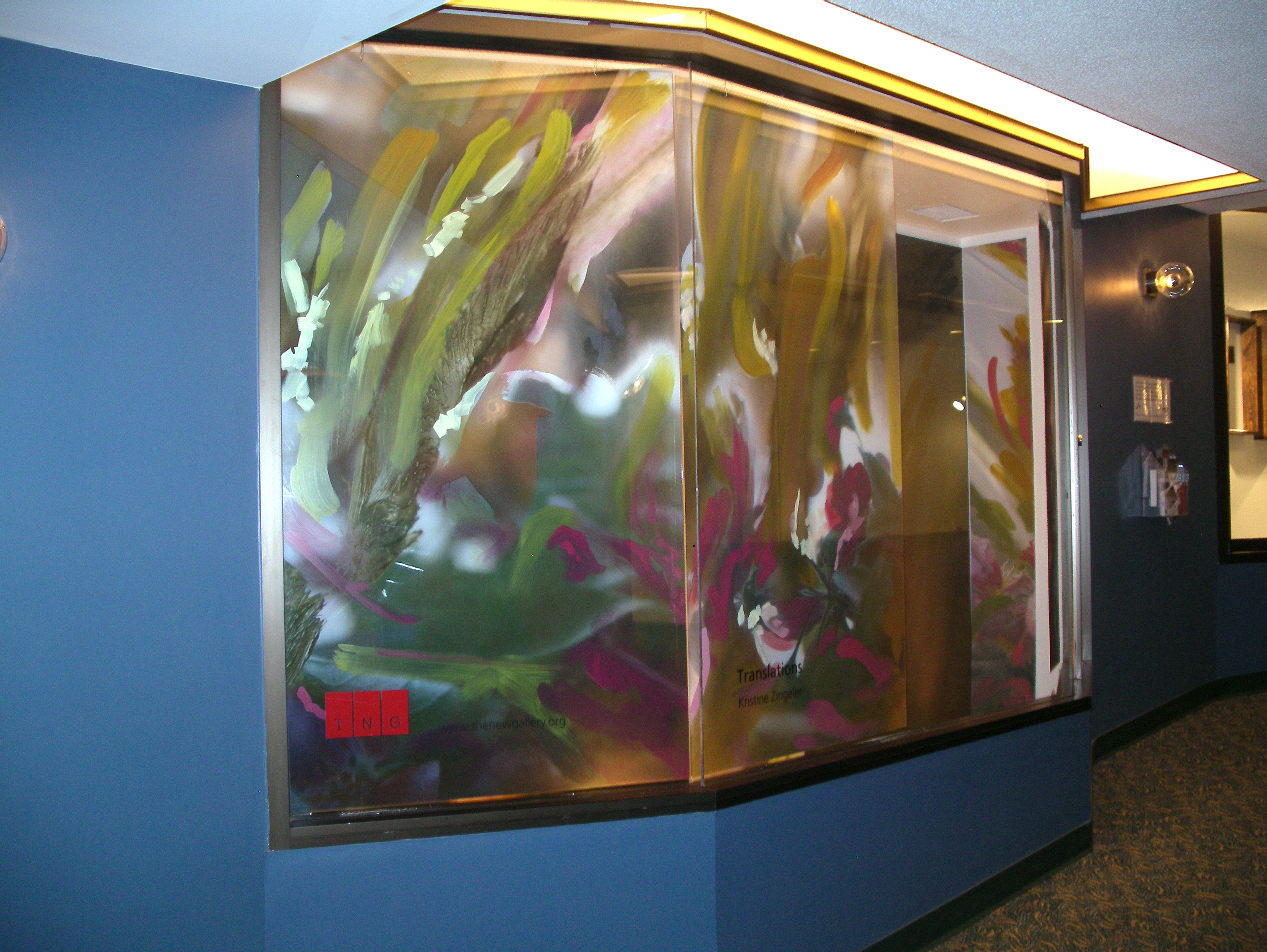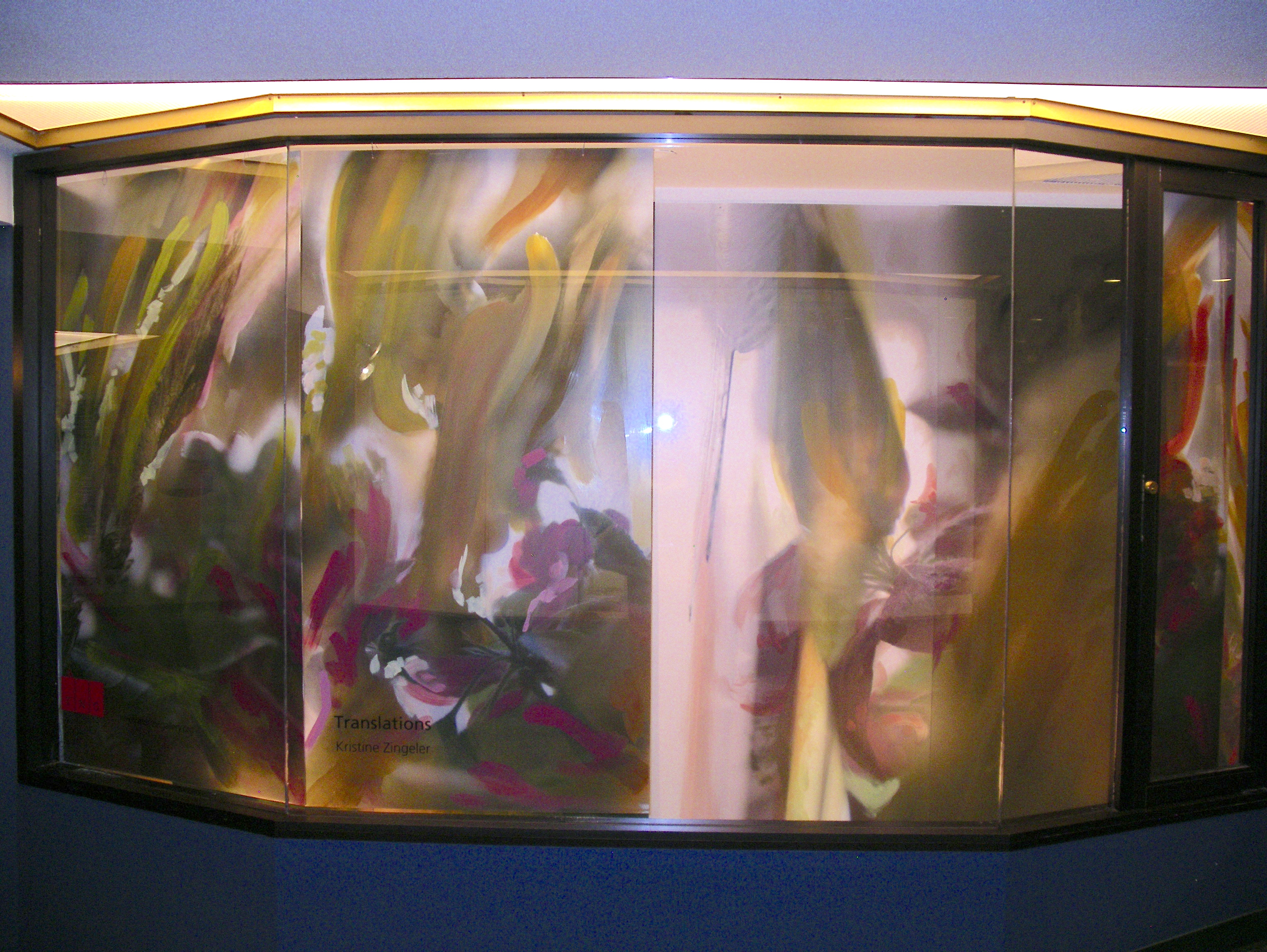
Translations
Kristine Zingeler
+15 Window Exhibition
August 3 to September 30, 2012
Zingeler’s work takes the form of a dialogue between two modes of representation, description and expression. The realism (description) is achieved through the use of photography and abstraction (expression), through the employment of painting, with a conversation between these two very different modes of interpretation developing on the surface of the substrate.
http://kristinezingeler.tumblr.com/



Artist statement
Each painting begins with a space. I am interested in using spaces that have subtle domestic markers which create emotional connections, like a carved wooden jewelry box or a handmade pillow. The objects are not chosen based on their implied meaning, they serve as aesthetic tools, bringing texture and colour into the composition. The meaning of these objects is created by the viewer once the painting is complete. I am simply providing a recognizable image within an abstract piece that serves as an access point to the painting. The space is chosen through a series of indefinable requirements that as an artist I have an innate understanding of. It is a combination of aesthetics and sensation, a feeling that I respond to and have a desire to elaborate on. Once I have an area in mind I create a layer consisting of painted clear mylar. I incorporate this into the space by bending and manipulating it within the composition and essentially create a temporary installation. The sole purpose of this is to set a stage for the future painted surface. With the space prepared I am ready to photograph it. When I photograph this set up I am actively searching with the camera for the angle that not only provides an adequate scaffolding for my mark-making, but also revisits the original feeling of the space. To translate this sensation to a flat surface it must be emphasized and embellished with both the camera and the brushstroke. The two mediums talk to each other and feed off one another’s artistic languages. I print my photographs large scale on Sintra using commercial sign making techniques that provide me with an image that is durable, lightweight and archival. Once I have the print I add more paint to its surface to continue the conversation and complete the piece. There are areas of the painting that are solely photograph and areas that are solely paint. By placing them together I am forcing a relationship. It is the in-between and ambiguous areas that are evidence of the discussion. Arguments flow into reconciliations with the various treatments of the surface responding to the underlying imagery. The photographic language speaks of documentation and observation. There are hints of architectural details like windows, doors, moulding and old chimneys. These structures imply a domestic setting and the decorative elements like curtains, artwork, plants and mirrors further enforce the idea that the spaces are functional and lived in. By employing photography to describe these objects they can be viewed as more than just background.
The focus of the photographic image determines the importance of each object and certain areas jump forward while others recede. The addition of the painted mylar within the photographic space further complicates the relationship between photo and paint. It acts as a sort of translator or neutral party in the discussion and bridges the gap between the two mediums. When I apply the paint to the print’s surface I work with the image, not against it, and the fact that there are already brush strokes incorporated before I start painting makes the evolution of the piece incredibly natural. The marks are not trying to describe anything, they are simply engaging in a discussion. The final stage of the painting is completed quickly and intuitively and is successful because it is not overworked. The photographic surface is incredibly thin and depth is achieved due to the nature of the material. When I apply the paint, I use the same thought process and play up the illusionary qualities of both materials. It becomes hard to distinguish the photograph from the physical paint and yet the question is not is this paint or photo, but what are the two mediums saying to each other across the surface of the substrate.
Certain areas completed with paint appear to be photographic and areas in the photo take on a painterly quality in an act of unusual symmetry. The photographic portion of the work is focused on the architectural and representational which acts as a symbol of the conventional method of viewing the world around us. Objects are recognizable and the spaces are familiar within our definition of a domestic setting. A connection can be established that draws the viewer in and makes them question what exactly they are looking at. The painted layer represents a completely separate, more artistic way of seeing. It is unreserved, intrusive creativity. The mark making is exaggerated and fully saturated leaving certain areas of the photograph completely obscured and others dramatically highlighted. The paint is responsive to it’s setting and therefore acts as a second way of describing it. The discussion between the two mediums becomes about the act of looking. The conventional way of seeing and the creative act of looking come together in a complex visual conversation.
